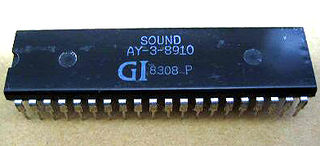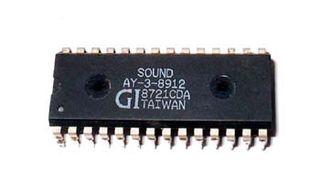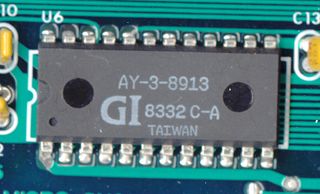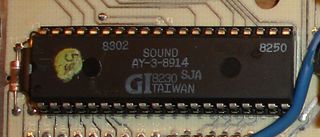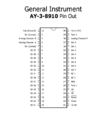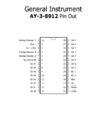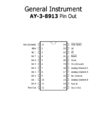AY-3-8910
| General Instrument AY-3-8910 Series | |
 |
|
| Developer: | General Instrument |
| Released: | 197?-??-?? |
| Type: | Chip |
| Channels: | 1.) Pulse Wave |
The AY-3-8910 is a series of programmable sound generators (PSGs) designed by General Instrument at the end of the 1970s. The series was very successful, becoming the most-used audio chip of the arcade industry through the early 1980s. The series consists of several chips including the 8910, 8912, 8913, 8914, each with a revision, and several licensed clones. These LSI circuits were able to produce various sounds by accessing them with software. The chip features 3 tone generators (each with a mixer), a noise generator, and an envelope generator which provides amplitude control. Though they were not designed for PCM, they could be programmed to play audio well enough to understand speech.
The AY-3-8910 began dipping in popularity in 1985, and by 1987 it had been eclipsed by Yamaha's new family of audio chips. However, it still held a niche in games that didn't require high-fidelity sound for several more years, particularly among mahjong, trivia, adult, and gambling games. The chip was also very popular in slot machines of the 1980s.
Contents
[hide]Versions
AY-3-8910
The AY-3-8910 is a 40 pin chip with two general-purpose 8-bit parallel I/O ports, A and B. The chip was revised and given the name AY-3-8910A. The AY-3-8910 was also licensed to other companies including Winbond who sold it as the WF19054, and Yamaha who sold it as the YM2149.
This version of the chip was by far the most popular for arcade developers, as the majority games that used the 891x series went with the 8910. The 8910 was also used in interchangeable arcade systems like the DECO Cassette System and the Cal Omega cabinets. In addition to hundreds of arcade games, the 8910 was used in the early versions of the Mockingboard sound card and several early home computer systems including the MSX, Oric 1, Coulour Genie, and the Elektor TV Games Computer.
AY-3-8912
The AY-3-8912 is the same as the AY-3-8910 only with a 28-pin footprint in order to save space on the circuit board. While the chip still has parallel port B functionality, only parallel port A is actually connected to any pins. The chip continued to be manufactured after Microchip Technology was spun off under the name AY38912/P. There is a revision chip called the AY-3-8912A/P.
The 8912 was very popular in European home computers and was used in the Vectrex, Amstrad CPC, and the ZX Spectrum 128. It was also used in a handful of arcade games and the ill-fated Amstrad GX4000 console. The chip could also be found in nearly every slot machine made by Bellfruit throughout the 1980s.
AY-3-8913
The AY-3-8913 is the same as the 24-pin chip only with both A and B parallel ports disconnected for an even smaller circuit board footprint. Though it didn't have parallel access, it still featured the same audio capabilities as the other chips. It was released approximately 6 months after the 8910 and 8912 chips. There is a revision chip called the AY-3-8913A.
While no home computers used the 8913, the chip can be found in a couple of arcade games. However, the biggest user of the 8913 was the the later Mockingboard sound cards--including the homebrew v1--each of which used two chips.
AY-3-8914
The AY-3-8914 is mostly the same as the 40-pin AY-3-8910 chip, only with a different pin layout and a 2-bit envelope and volume field. A revision chip was made with the name AY-3-8914A.
This was probably the least popular of the series and was only used in the Intellivision and Intellivision II video game consoles.
YM2149
See full article, YM2149.
The YM2149, also known as the Software-Controlled Sound Generator (SSG), is modified AY-3-8910 re-branded by Yamaha. The chip has twice the resolution as the original, but a double-rate volume envelope table. Pin 26 can be used to halve the master clock when pulled low. This chip was used by the MSX2, MSX2+, MSX2 TurboR, and Atari ST. It has several revisions, one of which is the YM2149F which was embedded in Sunsoft's 5B chip.
Additional revisions of the YM2148 include the YM3439, YMZ284, YMZ285, and the YMZ294; though, these do not appear to have ever been used in a video game.
AY8930/P
See full article, AY8930/P.
The AY8930/P was designed and sold by General Instrument's offshoot company, Microchip Technology. It improved on nearly every aspect of the original design and could also run in AY-3-8910 compatibility mode which made it mostly backward-compatible with the AY-3-8910.
Devices
Over the years, a number of computers, video game consoles, and peripheral devices used the AY-3-891x series of chips. This is a chronological breakdown of those devices, and which chips they used.
| Release | Device | Chip |
|---|---|---|
| 1979-??-?? | Intellivision | AY-3-8914 |
| 1980-??-?? | DECO Cassette System | AY-3-8910 |
| 1981-??-?? | Mockingboard: Sound I | AY-3-8910 |
| 198?-??-?? | Mockingboard: Sound II | 2x AY-3-8910 |
| 198?-??-?? | Mockingboard: A | 2x AY-3-8913 |
| 198?-??-?? | Mockingboard: C | 2x AY-3-8913 |
| 198?-??-?? | Mockingboard: D | 2x AY-3-8913 |
| 198?-??-?? | Mockingboard: M | 2x AY-3-8913 |
| 1981-??-?? | Cal Omega | AY-3-8912 |
| 1982-08-?? | Colour Genie | AY-3-8910 |
| 1982-11-?? | Vectrex | AY-3-8912 |
| 1982-??-?? | Intellivision II | AY-3-8914A |
| 1983-06-27 | MSX | AY-3-8910 |
| 1983-10-?? | Oric 1 | AY-3-8910 |
| 1983-??-?? | Aquarius Mini-Expander | AY-3-8914 |
| 1983-??-?? | Essex Micro Electronics SoundBoard | AY-3-8912 |
| 1984-??-?? | Amstrad CPC | AY-3-8912 |
| 1985-??-?? с | Bank Street Music Writer Card | AY-3-8913 |
| 1986-??-?? | ZX Spectrum 128 | AY-3-8912 |
| 198?-??-?? | Elektor TV Games Computer (Expanded Version) | 2x AY-3-8910 |
| 1987-??-?? | Player's Edge Plus | AY-3-8912 |
| 1987-??-?? | System 85 | AY-3-8912 |
| 1990-09-?? | GX4000 | AY-3-8912 |
| 2005-??-?? | Mockingboard v1 | 2x AY-3-8913 |
| 200?-??-?? | Mockingboard v1a | 2x AY-3-8913 |
Games
The 891x series was by-far the most used audio chip found in arcade games in the first half of the 1980s. The most common configurations was two AY-3-8910 chips used in tandem for 6 channels of audio, though developers used as many as five concurrent chips.
Note: Most of the chip information in the game list doesn't distinguish between A-revision chips and original design chips because the information comes from the MAME database. Further investigation must be made to figure out if the game uses the original chip or the revision chip.
1980
The AY-3-891x series was still quite new at this point. Though the chip came out at the end of the 1970s, it wasn't found in a released arcade cabinet until 1980, but already developers were seeing the benefit of using multiple chips for better audio fidelity.
The chip's growth in popularity in the upcoming year indicates that developers were starting to embrace the chip in 1980.
1981
The popularity of the 891x chip series tripled from 1980 to 1981 catapulting it to the most popular audio chip of the year by far. It would only grow in popularity for 1982.
Frogger (ARC) is one of the more popular games of the year to utilize this chip.
1982
With around 100 arcade games under its belt, the 891x remains the most widely used arcade audio chip for the second year in a row. While it will continue to be top the charts for a couple more years, it has already neared its peak usage.
Popular games to use these chips include Anteater (ARC), Burger Time (ARC), Kangaroo (ARC), Moon Patrol (ARC), Popeye (ARC), and Tron (ARC).
1983
The 891x series remained the most popular in 1983 with over 100 arcade games utilizing it for audio. The numbers would be about the same for next year, which means developers were still planning their upcoming games around it.
Popular 1983 games to use this chip series include 10-Yard Fight (ARC), Commando (ARC), Dragon's Lair (ARC), Elevator Action (ARC), Gyruss (ARC), Spy Hunter (ARC), and Tapper (ARC).
1984
Yet another 100+ games used the 891x series in 1984, keeping it well on the top, though the chip is now starting to show its age. Developers have been pushing it to the max, and Yamaha is starting to release new audio chips of their own.
Some of the more popular games to use this chip in 1984 include 1942 (ARC), Bomb Jack (ARC), Cobra Command (ARC), Gyrodine (ARC), Karate Champ (ARC), Lode Runner (ARC), and Seicross (ARC).
1985
1985 saw a noticeable drop in use of the 891x series with fewer than 100 games. Although the chip remained the most popular among developers, several competing Yamaha chips had entered the market. They were only used in a handful of games in 1985, but their numbers would grow significantly in the upcoming years.
Notable games from 1985 to use the 891x series include City Connection (ARC), Mag Max (ARC), and Road Blaster (ARC).
1986
The 891x series was well into its decline by 1986, being found in fewer than 60 games. Although it was still popular, it was being usurped by Yamaha's line of new audio chips and various Texas Instrument chips. No longer were developers using the 891x for their best games, it was now found in the games that didn't need quality music like poker, mahjong, and trivia games.
Notable games from 1986 to use the 891x include Kid Nikki: Radical Ninja (ARC) and Solomon's Key (ARC).
1987
Now in the sunset of its lifespan, the 891x shows up in only around 40 games. Nearly all of the popular games of this year were using one of the several Yamaha audio chips and the 891x has been demoted to cheaper gambling or adult games which utilize it more for sound effects than music. Notice how most games only use a single 891x chip which yields mono audio rather than two for stereo music.
There are no notable games to mention, however both the Player's Edge Plus and System 85 architectures made use of the AY-3-8912.
1988
Despite no longer being used in popular action games, the 891x still holds onto its niche of providing sound for gambling and adult games with another 30+ cabinets in 1988. However, Yamaha is slowly encroaching into this market as well.
1989
1989 depicts the finale of the 891x series. Despite the year being a boon for Mahjong games which traditionally used 891x chips, the majority of them are now using Yamaha chips for sound. Only about 25 games used the 891x this year, and very few were non-gambling games.
198?
Due to the nature of game cabinet distribution, a fair amount games were released with an unknown year. The following games were probably released in the 1980s, though more research is needed to properly determine the precise year. Since the AY-3-891x' series was the king of the first half of the 1980s, it's likely that they were released around the beginning and middle of the decade. Most of the games listed here are slot machines rather than arcade games.
1990
Entering the new decade, the 891x chip series still holds on to a small amount of the market share that relies on what is now viewed as low-quality audio. Mahjong games and slot machines are about all that's left of the 30 or so games using the 891x in 1990.
1991
The 891x series continues to lose ground as it becomes more and more irrelevant in the video game audio market. Only about 20 games utilize the 891x, still mostly mahjong and gambling games.
1992
Fewer than 20 games used the 891x series in 1992 marking an all-time low. All that remains are a few off-brand games, and the occasional quiz, slot, and mahjong games, but even these are often offset with a more impressive audio chip.
1993
Still with fewer than 20 games, the 891x hangs on to a niche market of slot machines and games that don't require high-fidelity music.
1994
The 891x continues to hold on for another year with slot machines and gambling games.
1995
Around 20 games seems to be the minimum for the 891x. Despite the chip now being completely out of date, it remains in use for assorted quiz, mahjong, and gambling games.
1996
The outdated 891x series saw an unexpected resurgence in 1996 with over 30 games.
Downloads
| Document | Download |
|---|---|
| Programmer's Manual | Download - (info) |
| Technical Specification | Download - (info) |
| Microchip Manual | Download - (info) |
| University Evaluation | Download - (info) |
Picture Gallery
AY-3-8913 on an Apple Mockingboard: M.
AY-3-8914, on an Intellivision.
AY-3-8914A, on an Intellivision II.
Emulation Status
MAME emulates each of the incarnations of the AY-3-8910 exceptionally well, as do most emulators for Intellivision, Apple II, Vectrex, Amstrad CPC, ZX Spectrum 128, and all incarnations of the MSX.
Links
- en.wikipedia.org/wiki/General_Instrument_AY-3-8910 - Wikipedia.
- bulba.untergrund.net/main_e.htm - AY-3-8910 fan page.
- mamedev.org/source/src/emu/sound/ay8910.c.html - AY-3-891x MAME emulation source code.
- sdiy.info/w/General_Instrument_AY-3-8910 - Chip information.
